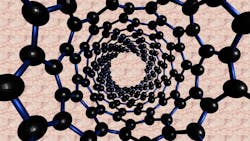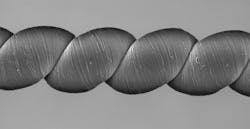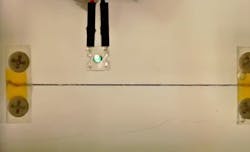>> Website Resources
.. >> Library: TechXchange
.. .. >> TechXchange: Power Management
.. .. .. >> Topic: Energy Harvesting
There’s apparently little limit to the ingenuity being used to seek out unique and innovative ways to get something for (almost) nothing via energy harvesting. Among the many options are thermal gradients, temperature swings, waste heat, impinging light, sound waves, wind, and vibration, to cite a few more obvious ones. But what if your clothes could be the storage harvested source?
A team at the NanoTech Institute at the University of Texas (Dallas), in partnership with a similar group at Hanyang University (Seoul, South Korea), is looking to do just that, using fibers created with carbon-based nanotubes that they dubbed “twistrons.” These nanotube fibers create supercapacitors when coated with, or submerged in, an electrolyte such as salt water, and then acquire and store potential as electrical charges are moved by the twisting motion of the fibers within the supercapacitor.
They report capacitances as high as 300 F/gm and power harvesting up to 250 kW/kg with 30 stretches/sec. However, it’s important to keep in mind that the volume of such capacitors is huge since the nanotube-based fiber materials are extremely light.
Their work, published in AAAS Science, “Harvesting electrical energy from carbon nanotube yarn twist,” explains how they created the tubes and used them in demonstration projects. Dr. Na Li, a research scientist at the UT NanoTech Institute and co-lead author of the study, said “Fundamentally, these yarns are supercapacitors. In a normal capacitor, you use energy—like from a battery—to add charges to the capacitor. But in our case, when you insert the carbon nanotube yarn into an electrolyte bath, the yarns are charged by the electrolyte itself. No external battery, or voltage, is needed.”
1. The supercapacitors are built of twisted yarns called twistrons made of fibers of carbon nanotubes, serving as both source and storage medium for the electrical energy generated as the fibers twist and unwind when stretched and relaxed. (Source: University of Texas)
The process begins with carbon nanotubes, hollow cylinders that are about 10 nm is diameter. Multiple fibers are spun-twisted into yarn, which in turn is made very elastic by “overtwisting” the strands, analogous to winding up a rubber band (Fig. 1). When a harvester yarn is then twisted due to motion, it decreases the volume of the carbon nanotube yarn. This moves the electric charges on the yarn closer together and increases their stored energy associated with the charges stored in the yarn, which can then be extracted.
By connecting a twistron yarn to an artificial muscle polymer (another one of their areas of research), which contracts and expands when heated and cooled, researchers demonstrated how these yarns could extract and store electrical energy due to motion. Check out the Science/AAAS video:
In the lab, the researchers showed that a twistron yarn weighing a few milligrams could power a small LED, which lit up each time the yarn was stretched (Fig. 2).
They also sewed twistrons into a shirt, and normal breathing stretched the yarn and generated an electrical signal; they speculate that perhaps even a self-powered respiration sensor is possible. On a much-larger scale, ocean water could be used as the electrolyte, as shown by co-lead author Dr. Shi Hyeong Kim of the of the UT NanoTech Institute.
2. In a basic demonstration, an LED was powered by the stretching of a twistron yarn. (Source: ars technical)
Kim attached a 10-cm, 1-mg strand of yarn between a balloon and a sinker that rested on the seabed. As each ocean wave passed, the balloon would rise, stretching the yarn up to 25% and generating a measurable amount of power. Of course, many innovative energy-storage and harvesting projects don’t work out successfully in the real world due to issues of cost, manufacturability, reliability, physical wear, energy density, efficiency, and other factors.
Still, the investigators have filed a patent on the technology. In the U.S., the research was funded by the Air Force, the Air Force Office of Scientific Research, NASA, the Office of Naval Research, and the Robert A. Welch Foundation. In Korea, the research was supported by the Korea-U.S. Air Force Cooperation Program and the Creative Research Initiative Center for Self-powered Actuation of the National Research Foundation and the Ministry of Science.
>> Website Resources
.. >> Library: TechXchange
.. .. >> TechXchange: Power Management
.. .. .. >> Topic: Energy Harvesting
About the Author

Bill Schweber
Contributing Editor
Bill Schweber is an electronics engineer who has written three textbooks on electronic communications systems, as well as hundreds of technical articles, opinion columns, and product features. In past roles, he worked as a technical website manager for multiple topic-specific sites for EE Times, as well as both the Executive Editor and Analog Editor at EDN.
At Analog Devices Inc., Bill was in marketing communications (public relations). As a result, he has been on both sides of the technical PR function, presenting company products, stories, and messages to the media and also as the recipient of these.
Prior to the MarCom role at Analog, Bill was associate editor of their respected technical journal and worked in their product marketing and applications engineering groups. Before those roles, he was at Instron Corp., doing hands-on analog- and power-circuit design and systems integration for materials-testing machine controls.
Bill has an MSEE (Univ. of Mass) and BSEE (Columbia Univ.), is a Registered Professional Engineer, and holds an Advanced Class amateur radio license. He has also planned, written, and presented online courses on a variety of engineering topics, including MOSFET basics, ADC selection, and driving LEDs.



